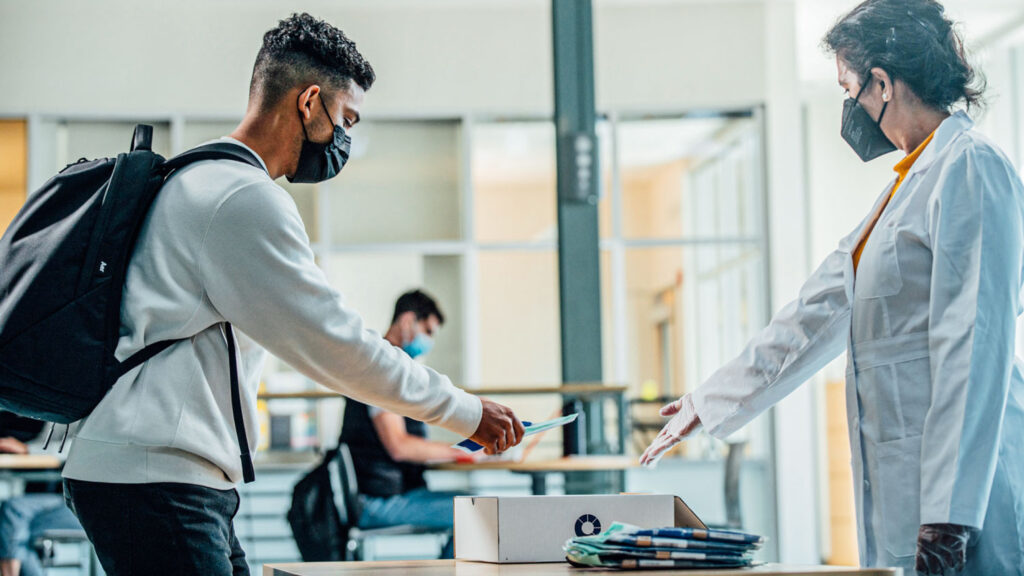News & Articles
COVID-19 Testing and Vaccination Terminology
Color

Looking into COVID-19 tests for yourself or your organization? The first step is understanding the terminology and types of tests available. It can be a bit confusing — and the same goes for COVID-19 vaccines, so we’ve put together this quick overview of essential COVID-19 testing and vaccination terminology to make it easier for you.
Testing terminology
Diagnostic tests — also called viral tests — show if you are actively infected with SARS CoV-2, the virus that causes COVID-19. There are two main types of diagnostic tests: NAATs and antigen tests.
Nucleic acid amplification tests
NAATs, or nucleic acid amplification tests, detect the genetic material — the ribonucleic acid or RNA — of the SARS-CoV-2 virus. These tests are highly sensitive, and are considered to be the gold standard for accuracy. NAATs are also called molecular tests. NAATs typically require upper or lower respiratory samples, such as nasal swabs, throat swabs, or saliva. NAATs can either be lab-based, with a one- to three-day turnaround time, or rapid point-of-care tests, with a turnaround time of 30 minutes to one hour.
PCR and LAMP are two common types of NAATs. PCR stands for polymerase chain reaction, a laboratory method used to make billions of copies of a small, specific DNA sample, amplifying it so it can be studied in detail. LAMP (loop-mediated isothermal amplification) is a newer technique that’s more efficient and cost effective.
Some PCR and LAMP tests can be self-administered, without requiring clinical staff. For example, Color’s self-swab test kits can be activated and used on-site or at home and then shipped to the laboratory for processing.
Antigen tests
Antigen tests detect the presence of a protein that’s part of the SARS-CoV-2 virus. Sometimes referred to as “rapid” tests, most antigen tests can produce results without a laboratory in 15 to 30 minutes. Speed and cost are the main advantages of antigen tests, but they are less sensitive, which means there is a higher chance of false negatives.
Lab-based tests vs. rapid point-of-care tests
Since PCR tests are a type of NAAT — the gold standard — rapid PCR tests are more accurate than antigen tests. Both rapid PCR and rapid antigen tests can produce results onsite in around 15 to 30 minutes, while lab-based tests typically take a day, and sometimes up to three days.
Antibody tests
Antibody tests — not to be confused with antigen tests — are not diagnostic and cannot diagnose an active COVID-19 infection; rather, they are used to identify past infection. They look for antibodies made by your immune system to fight infections.
Approaches to testing
In contrast to individual testing, pooled testing is an approach that combines two or more specimens for a single NAAT laboratory test. If the pooled test is negative, everyone who contributed a sample receives negative test results. If the pooled test comes back positive, each person must be individually retested. Since this method uses fewer resources, pooled testing can be conducted at a lower cost.
Screening or proactive testing an approach that tests all individuals regardless of whether they have symptoms or are suspected of infection. This is important because infected individuals can spread the virus before symptoms develop, with an estimated 15 to 30% of cases being asymptomatic.
Sensitivity and specificity
Sensitivity and specificity are measures of a test’s accuracy. Sensitivity measures how well a test detects disease, that is, the proportion of patients who correctly get a positive result. Specificity is a measure of how well it detects the absence of disease, or the proportion of patients who correctly get a negative result.
Sensitivity is defined as the proportion of patients with Covid-19 who correctly get a positive result, while specificity is the proportion of patients without an infection that the test correctly identifies as negative. NAAT tests such as PCR and LAMP are considered the gold standard because they are both highly sensitive and highly specific.
Vaccination terminology
An antibody is a protein in the blood produced in response to foreign substances invading the body, such as viruses or bacteria. Antibodies bind to these organisms and destroy them to protect the body from disease.
Immunity is protection from a disease. People who are immune to a disease can be exposed to it without becoming infected.
A vaccine is a substance that prompts the immune system to recognize a specific pathogen, such as a virus, and create antibodies to destroy it. Many vaccines work by putting a weakened or inactivated pathogen into the body to produce antibodies. However, both the Pfizer-BioNTech and Moderna COVID-19 vaccines are mRNA vaccines and don’t contain pathogens.
mRNA vaccines: Both the Pfizer-BioNTech and Moderna COVID-19 vaccines are mRNA vaccines. They use mRNA (messenger ribonucleic acid) to instruct cells to produce a protein that is found in the SARS CoV-2 virus, which will trigger an immune response — the production of antibodies — if the body is exposed to that protein.
A breakthrough infection is when a person develops a disease despite having responded to a vaccine.
Booster shots are additional doses of a vaccine needed periodically to “boost” the immune system. For example, adults who have received Tdap, the vaccine that prevents tetanus, diphtheria, and pertussis, need to have a booster every ten years.
Herd immunity is when enough people in a population have developed immunity to a disease so that it becomes difficult for it to spread. In the case of COVID-19, scientists originally estimated that about 70% of the population would need to be vaccinated to achieve herd immunity. Now many experts believe that the U.S. won’t be able to reach herd immunity.
Vaccine effectiveness is a measure of how well a vaccine works in typical field conditions. (Vaccine efficacy is a measure of how well a vaccine works in ideal conditions.) Both are expressed as a percentage that shows the proportionate reduction in disease among the vaccinated group. A vaccine that’s 90% effective means there will be a 90% reduction in disease among the vaccinated group, or a 90% reduction in the number of cases you would expect if they hadn’t been vaccinated.Visit the CDC website for more information on testing and vaccination.
Visit the CDC website for more information on testing and vaccination.



